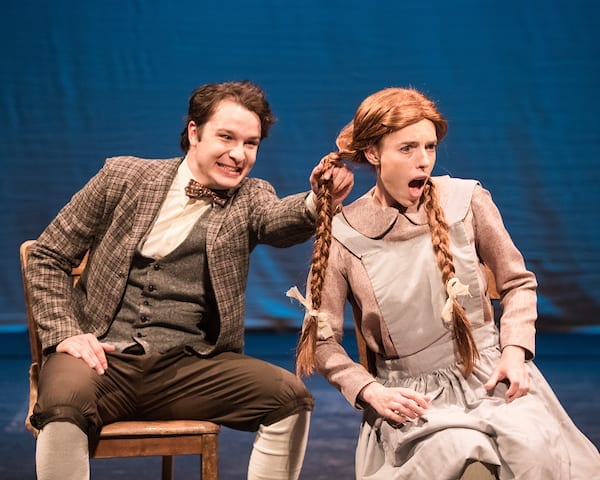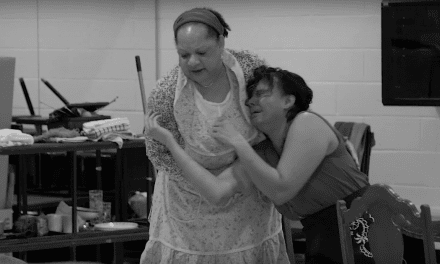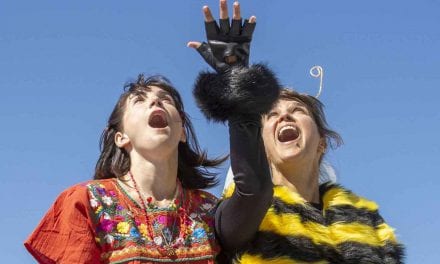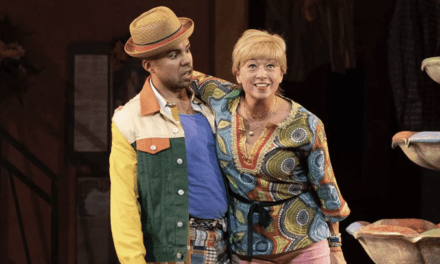PROVO — Those familiar with Lucy Maud Montgomery’s 1908 novel Anne of Green Gables and its many sequels know that the title character’s exuberant imagination always makes readers wonder what is coming next. BYU’s staging of Peter DeLaurier’s adaptation, directed by Teresa Dayley Love, made me wonder this too, but mostly because the number of scene changes gave me a lot of chances to consider the question. Fortunately, winning performances in the younger roles still shone through the cracks, allowing the guileless spirit of Montgomery’s characters to transcend the production’s choppy rhythm.

Show closes June 16, 2018.
Anne of Green Gables tells the story of Anne Shirley (played by Esther Pielstick), a romantic, talkative, red-headed orphan girl, and how she comes to be adopted by Matthew and Marilla Cuthbert (played by Reese Purser and Mary Jane Wadley), an elderly brother and sister who live in the farming town of Avonlea on Prince Edward Island. Pielstick believably inhabits a twelve-year-old in her physicality and volubility of temper and does a credible job varying her levels to make her lengthy speeches interesting. I enjoyed watching Pielstick shape her performance as Anne grows and matures, but wish DeLaurier’s script would have given her a few more scenes in the middle of that trajectory.

Esther Pielstick as Anne Shirley and Reese Purser as Matthew Cuthbert. Photo by Savanna Richardson.
The contours of Matthew and Marilla’s character arcs are not as defined as Anne’s. Though the scene in which Marilla finally expresses her love for Anne still lands emotionally (if cut too short—it needed another beat), it doesn’t feel like it costs her enough to get to that point. From the very beginning, both she and Matthew wear their feelings on their sleeves too much and don’t appear to need Anne to draw them out after decades of emotional reserve. To give one example (for which the playwright bears some responsibility), in what universe would no-nonsense Marilla Cuthbert perform a lively imitation of Anne? Matthew is also far too boisterous from the get-go, huffing and pouting to get his way. Audience members who are familiar with the source material will be surprised to hear him raise his voice on more than one occasion. I am absolutely open to unexpected takes on well-known characters, but this version of Matthew Cuthbert didn’t work for me.
A reversible wooden frame to evoke Green Gables comprises most of Nat Reed’s set, with occasional other trappings like a rowboat or a train station sign. The trees in the background did strike me as too sinuous for Canada, however, the spareness of the set felt right for the piece overall—I’m not sure the Cuthberts would feel at home in anything more elaborate. The scene changes were managed by a group of children in costume who sometimes bled into the action a little on either end of the blackouts, which I would have liked to have seen more of. Though their efficiency kept the scene changes generally short, blackouts were so frequent that, in the aggregate, I felt like I spent a lot of time sitting in the dark watching chairs being moved around.

Mary Jane Wadley as Marilla Cuthbert. Photo by Savanna Richardson.
A note in the program from the publisher and playwright compounded this impression. They comment that they have authorized “substantial cuts” to the script in order to bring it “within the time limit of the Young Audience series,” and express their wish that the audience could “experience the two-hour play as written.” Yet, by some alchemical process, these “substantial cuts” have still resulted in a production that exceeds the original runtime, even after subtracting the intermission.
Moreover, the music that underscores the set changes (composed by Landon Alley) also drew attention to the amount of down time. For one thing, despite the studio musicians listed in the program, too much of it was orchestrated with unflattering synthesizer instruments that detracted from the atmosphere. In addition, the music never established a core stylistic or thematic identity. At one point it wanted to be new age-inflected, piano-based material, then a movie trailer, then a TV comedy, and so on. Furthermore, one scene change inexplicably featured Jack Johnson’s cover of “We’re Going to Be Friends.”
Inconsistency aside, however, at least this last song does speak to the production’s strengths. Perhaps because of the director’s experience with young audiences, the best scenes in the play were those focused on childhood friendships. These include the charming, buoyant reenactment of Anne’s run-in with Gilbert Blythe (played by Derek Johnson) at school that Ruby Gillis (played by Hannah Staley Foster) and Jane Andrews (played by Claire Eyestone) perform for the adults back at Green Gables as well as Anne’s ill-fated tea party with her best friend Diana Barry (played by Calee Gardner). That said, I would like to know why Marilla’s currant wine resembles pink lemonade. Not only is currant wine not pink, but if it were, how then could Anne be forgiven for confusing it with raspberry cordial?
Hayley Flanders Anderson—who gives distinct portrayals of three different characters—captures something of this production’s contradictions in her interpretation of the dramatic busybody Rachel Lynde. I particularly appreciated that, when she first meets Anne and is criticizing her looks, Anderson made the choice to move to embrace the girl. Mrs. Lynde’s extended arms allow her inherent kindness to show through her lack of tact. In a similar way, this Anne of Green Gables doesn’t always frame its fundamental goodness the best that it possibly can, but that doesn’t mean it isn’t there.
Donate to Utah Theatre Bloggers Association today and help support theatre criticism in Utah. Our staff work hard to be an independent voice in our arts community. Currently, our goal is to pay our reviewers and editors. UTBA is a non-profit organization, and your donation is fully tax deductible.





